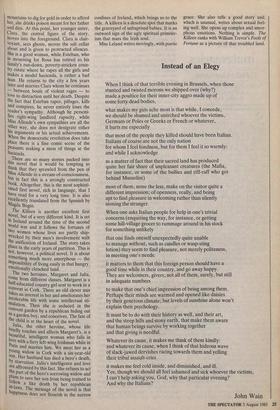Magical Chile and unhappy Ireland
Harriet Waugh
THE HOUSE OF THE SPIRITS by Isabel Allende
Cape, £8.95
THE KILLEEN by Mary Leland
Hamish Hamilton, £895
Isabel Allende's exceptionally mature first novel, The House of the Spirits, is in the mainstream of South American fiction. This does not diminish its achievement but it does reduce the feeling of dazzlement that most Westerners experience when reading their first South American novel. The first South American novel I read was One Hundred Years of Solitude by Gabriel Garcia Marques, which still shines in my memory as one of the most extraordinary and wonderful books of this century, with its mixture of magic, humour, horror, family saga and socio-political drama. If I had first read Miss Allende's novel — which has much the same mix — I might well have thought her's one of the most outstanding, instead of which it merely seems very good indeed. Although it has much the same kind of ingredients as One Hundred Years of Solitude, its magic gra- dually dies away as a terrible political reality engulfs the people of the country. Ghosts, the gift of foretelling the future and the ability to make the pepper and salt cellars move around the dining-room table cannot survive terror, mass-murder and torture.
The novel follows the fortunes of four generations of a rich, middle-class family in a country which is obviously Chile. The earliest generation is a lively liberal family with two distinguished daughters. The old- est, Rosa, is remarkable for her great beauty, amazing green hair and her draw- ings of strange, unlikely animals. She becomes engaged to an impoverished middle-class clerk, Esteban Trueba — the only male character that is dealt with in depth — because no one else will marry her. Although she is adored, no man feels sufficiently confident of holding her against all other men's challenge. Unfortunately, while Esteban Trueba goes off to the mountains to dig for gold in order to afford her, she drinks poison meant for her father and dies. At this point, her younger sister, Clara, the central figure of the story, moves into the foreground. Clara is clair- voyant, sees ghosts, moves the salt cellar about and is given to protracted silences. She is a good woman, while Esteban, who in mourning for Rosa has retired to his family's run-down, poverty-stricken coun- try estate where he rapes all the girls and makes a model hacienda, is rather a bad man. He returns to the city a few years later and marries Clara whom he continues — between bouts of violent rages — to love to distraction until her death. Despite the fact that Esteban rapes, pillages, kills and conspires, he never entirely loses the reader's sympathy. Although he personi- fies right-wing landlord rapacity, while Miss Allende's own sympathies are all the Other way, she does not denigrate either his arguments or his actual achievements. When the democratic revolution does take Place there is a fine comic scene of the Peasants making a mess of things at the hacienda.
There are so many stories packed into this novel that it would be tempting to think that they sprawled from the pen of Miss Allende in a stream-of-consciousness, but in fact this is a strongly constructed book. Altogether, this is the most sophisti- cated first novel, rich in language, that I have read for a very long time. It is also excellently translated from the Spanish by Magda Bogin. The Killeen is another excellent first 111. ovel, but of a very different kind. It is set In Ireland around the time of the second world war and it follows the fortunes of hvo women whose lives are partly ship- wrecked by their men's involvement with the unification of Ireland. The story takes Place in the early years of partition. This is not, however, a political novel. It is about s. omething much more amorphous — the nnpossibility of living easily in that hungry, emotionally clenched land. The two heroines, Margaret and Julia, come from different classes. Margaret is a half-educated country girl sent to work in a convent in Cork. There an old clever nun takes an interest in her and ameliorates her Intolerable life with some intellectual sti- mulation. Then she is seduced in the convent garden by a republican hiding out as a garden boy, and conceives. The fate of the child is at the heart of the novel. Julia, the other heroine, whose life briefly touches and affects Margaret's, is a beautiful, intelligent woman who falls in love with a fiery left-wing Irishman while in Pans and marries him. We meet her as a Young widow in Cork with a six-year-old son. Her husband has died a hero's death, by starvation. Julia's intelligence and love are affronted by this fact. She refuses to act the part of the hero's sorrowing widow and plans to save her son from being trained to follow a like death by her republican in-laws. The message of the novel is that happiness does not flourish in the narrow confines of Ireland, which brings us to the title. A killeen is a desolate spot that marks the graveyard of unbaptised babies. It is an outward sign of the ugly spiritual primitiv- ism that mars the Irish soul.
Miss Leland writes movingly, with poetic grace. She also tells a good story and, which is unusual, writes about sexual feel- ing well. She opens up complex and amor- phous emotions. Nothing is simple. The Killeen ranks with William Trevor's Fools of Fortune as a picture of that troubled land.











































 Previous page
Previous page